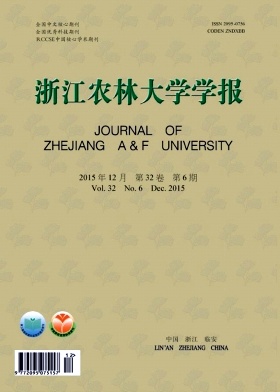Screening of a cellulose-decomposing strain from bamboo stand soils and optimization of its cellulase production
doi: 10.11833/j.issn.2095-0756.2015.06.001
浙江省科学技术重点项目(2012T201-05)
- Received Date: 2015-01-08
- Rev Recd Date: 2015-03-09
- Publish Date: 2015-12-20
-
Key words:
- forest microbiology /
- cellulose-decomposing microorganisms /
- screen /
- enzyme production /
- optimization
Abstract: Cellulose, the most extensive and abundant renewable resource in nature with an annual worldwide accumulation of photosynthetic plant cellulose materials of 1012 t of which an estimate of 89% has been used unreasonably (such as in direct burning), should be produced by more effective cellulolytic microorganisms to transform these renewable resources into available energy. At present, although important research about screening cellulolytic microorganisms has been conducted, few studies on isolating and screening cellulose-decomposing microorganisms from bamboo stand soils have been described. This research isolated and screened efficient cellulolytic microorganisms from bamboo stand soils based on the size of transparent circles and the activity of carboxymethyl-cellulase (CMCase). An efficient cellulose-decomposing fungus, J6-1, was obtained and preliminary morphological observation identified it as Penicillium (Strain J6-1). On the basis of single-factor experiments, the orthogonal experiment of 4 factors at 3 levels was then taken to optimize the liquid fermentation conditions conditions of cellulase production. And the hereditary stability of cellulase produced Strain J6-1 was evaluated by the cellulase activity analysis of 5 consecutive generations. Experimental results showed that the optimum conditions for cellulase production were as follows: 15.0 gL-1 straw powder as carbon, 3.0 gL-1 yeast extract as a nitrogen source, a 10% inoculation quantity, fermentation at 40 ℃, and an initial pH of 5.0 for 5 d. After optimization of strain J6-1, the highest activity of carboxymethyl-cellulase (CMCase) was 41.82 16.67 katL-1 and filter paper enzyme activity (FPAase) was 17.26 16.67 katL-1. Thus, these characteristics of high cellulose activity could be subcultured serially, and strain J6-1 could be used for further practical application.[Ch, 3 fig. 3 tab. 34 ref.]
| Citation: | JIANG Yujian, LI Xinxin, SUN Feifei, YU Xuejun. Screening of a cellulose-decomposing strain from bamboo stand soils and optimization of its cellulase production[J]. Journal of Zhejiang A&F University, 2015, 32(6): 821-828. doi: 10.11833/j.issn.2095-0756.2015.06.001 |






 DownLoad:
DownLoad: